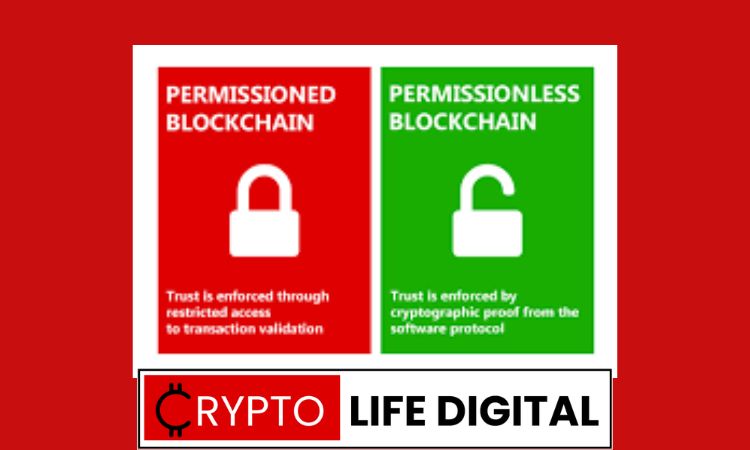Permissioned Vs Permissionless Blockchain

Blockchain technology has become a buzzword in the technology industry in recent years. It has gained significant attention due to its potential to revolutionize the way various industries operate. However, there are two primary types of blockchain networks: permissioned and permissionless. These two categories differ significantly in terms of their architecture, participants, and functionality. This article aims to explore the differences between permissioned and permissionless blockchains.
What is a Blockchain?
Before we dive into the differences between permissioned and permissionless blockchains, let’s first understand what a blockchain is. A blockchain is a decentralized and distributed digital ledger that records transactions on multiple computers. This technology allows participants to share a single view of the ledger, making it easier to track and verify transactions. Each block in the chain contains a set of transactions, a timestamp, and a unique code called a hash. Once a block is added to the chain, it cannot be altered or deleted.
A blockchain can be permissioned or permissionless, depending on its design and governance.
Permissioned Blockchains
A permissioned blockchain is a private blockchain network where participants have to gain permission before they can join and participate in the network. The permissioned blockchain is sometimes referred to as a consortium blockchain. It is designed for a specific group of participants who want to share information and collaborate in a secure environment. The participants in a permissioned blockchain network are known, and each participant has a specific role and responsibility.
Read Also: Cremation Coin Burns Over 106 Million LUNC, Now The 3rd Highest Burner
Permissioned blockchains have several key characteristics that differentiate them from permissionless blockchains. These include:
- Access Control: In a permissioned blockchain, access to the network is controlled, and participants are vetted before they are allowed to join. This ensures that only authorized participants can access the blockchain network, which enhances the security and privacy of the network.
- Governance: A permissioned blockchain is governed by a group of authorized participants who make decisions about the rules and regulations of the network. This ensures that the network operates in a transparent and efficient manner.
- Privacy: Permissioned blockchains offer greater privacy compared to permissionless blockchains because access to the network is controlled, and participants are known. This makes it easier to protect sensitive information and prevent unauthorized access to the network.
- Scalability: Permissioned blockchains are generally more scalable compared to permissionless blockchains because they have fewer participants. This makes it easier to process transactions and maintain the network’s performance.
Permissionless Blockchains
A permissionless blockchain is a public blockchain network that is open to anyone who wants to participate in the network. Participants in a permissionless blockchain network do not need permission to join, and there are no restrictions on who can participate. Anyone can read, write, and participate in the network without being vetted or authorized.
Permissionless blockchains have several key characteristics that differentiate them from permissioned blockchains. These include:
- Decentralization: Permissionless blockchains are decentralized, which means that there is no central authority or governing body controlling the network. Instead, the network is maintained by a network of nodes that work together to validate transactions and maintain the blockchain.
- Transparency: Permissionless blockchains are transparent, which means that anyone can view the blockchain’s contents and transactions. This enhances the trust and accountability of the network.
- Immutability: Permissionless blockchains are immutable, which means that once a transaction is recorded on the blockchain, it cannot be altered or deleted. This ensures the integrity and accuracy of the network.
- Security: Permissionless blockchains are generally more secure compared to permissioned blockchains because they are maintained by a network of nodes. This makes it more difficult for bad actors to manipulate the network or corrupt the data.
Read Also: Terra Classic Stakes Over 9 Billion in A Week, Almost 1.8 Billion In 24 hours
Differences between Permissioned and Permissionless Blockchains
There are several key differences between permissioned and
permissionless blockchains. These include:
- Governance: The governance model of permissioned and permissionless blockchains is significantly different. In a permissioned blockchain, the network is governed by a group of authorized participants who make decisions about the network’s rules and regulations. In contrast, a permissionless blockchain is governed by a decentralized network of nodes that work together to validate transactions and maintain the blockchain.
- Access Control: In a permissioned blockchain, access to the network is controlled, and participants must gain permission before they can join the network. In contrast, a permissionless blockchain is open to anyone who wants to participate in the network.
- Privacy: Permissioned blockchains offer greater privacy compared to permissionless blockchains because access to the network is controlled, and participants are known. In contrast, a permissionless blockchain is transparent, and anyone can view the network’s contents and transactions.
- Scalability: Permissioned blockchains are generally more scalable compared to permissionless blockchains because they have fewer participants. This makes it easier to process transactions and maintain the network’s performance.
- Speed: Permissionless blockchains are generally slower compared to permissioned blockchains because they require a consensus mechanism that ensures all nodes agree on the state of the blockchain. In contrast, permissioned blockchains can use faster consensus mechanisms that require fewer nodes to agree.
- Cost: Permissioned blockchains are generally more expensive to operate compared to permissionless blockchains because they require more infrastructure and governance. In contrast, permissionless blockchains are less expensive to operate because they are maintained by a decentralized network of nodes.
Examples of Permissioned and Permissionless Blockchains
There are several examples of permissioned and permissionless blockchains. Some of the popular permissioned blockchains include:
- Hyperledger Fabric: This is a permissioned blockchain that is designed for enterprises. It allows participants to create private channels where they can share information and collaborate.
- Corda: Corda is a permissioned blockchain that is designed for financial institutions. It enables participants to share financial information and execute financial transactions securely.
- Quorum: Quorum is a permissioned blockchain that is designed for enterprises. It is built on Ethereum technology and allows participants to create private networks where they can share information and execute smart contracts.
Some popular permissionless blockchains include:
- Bitcoin: Bitcoin is a permissionless blockchain that is used for peer-to-peer transactions. It allows anyone to participate in the network and does not require permission to join.
- Ethereum: Ethereum is a permissionless blockchain that enables participants to create and execute smart contracts. It allows anyone to participate in the network and does not require permission to join.
- Litecoin: Litecoin is a permissionless blockchain that is similar to Bitcoin but has faster transaction times and lower fees.
In conclusion, permissioned and permissionless blockchains differ significantly in terms of their architecture, participants, and functionality. While permissioned blockchains offer greater privacy and control, permissionless blockchains offer greater transparency and decentralization. The choice between a permissioned and permissionless blockchain will depend on the specific needs and requirements of the network’s participants.
Follow us on Twitter, Facebook, Telegram, and Google News

Dr. Olajide Samuel juggles the demands of medical studies with a passion for cryptocurrency. A seasoned blogger, Olajide shares his vast global knowledge of the crypto space, offering insights to enthusiasts. Despite his busy schedule, his commitment to crypto remains strong, and he actively seeks ways to contribute to its future.







